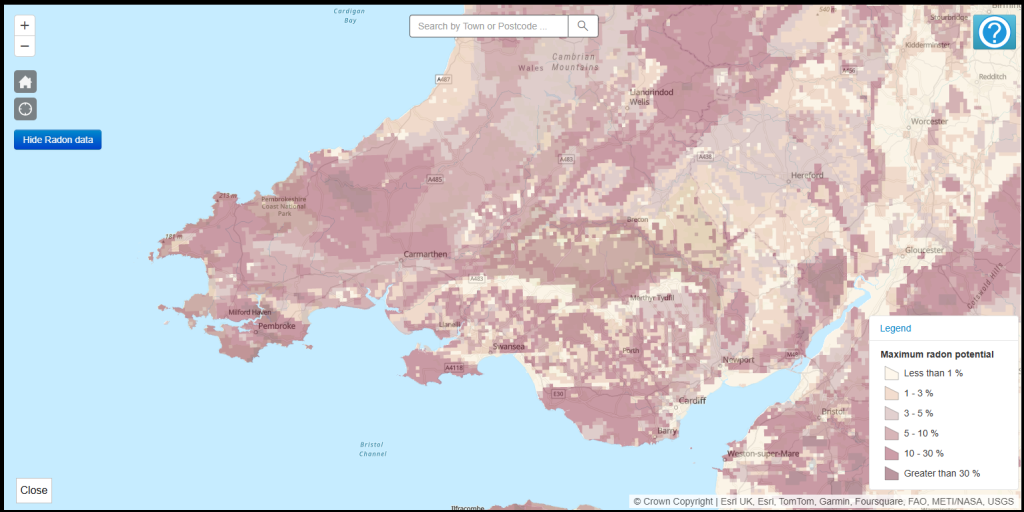
Radon is a naturally occurring radioactive gas that forms from the decay of uranium in rocks, soil, and water. Invisible, odourless, and tasteless, radon is undetectable without specialised equipment, making it a hidden but significant threat to health. It is the leading cause of lung cancer among non-smokers and the second-leading cause overall, with approximately 1,100 deaths attributed to radon exposure annually in the UK.
The Science Behind Radon
Radon is part of the uranium decay chain, releasing alpha particles during its breakdown. When inhaled, these particles can damage lung tissue, potentially leading to cancer. The risk of developing radon-related lung cancer increases with prolonged exposure and is significantly higher for smokers due to the compounding effects of tobacco smoke.
Radon levels are measured in becquerels per cubic metre (Bq/m³). Outdoor concentrations are typically low due to atmospheric dilution. However, in enclosed spaces such as homes and workplaces, radon can accumulate to dangerous levels, particularly in poorly ventilated areas. Regions in South Wales are known for higher radon levels due to their geology.
How Radon Enters Buildings
Radon moves from the ground into buildings through cracks in floors and walls, construction joints, and gaps around service pipes. Differences in air pressure between the soil and building interiors exacerbate this movement. Basements and crawl spaces, being closer to the ground, are particularly vulnerable.
Building materials containing trace uranium, like stone and concrete, can further contribute to indoor radon levels. Seasonal factors also play a role; for example, homes sealed during winter to conserve heat often experience increased radon levels due to reduced ventilation.
Testing for Radon: A Crucial First Step
Testing is the only way to determine radon levels. Short-term detectors offer initial insights, while long-term detectors, measuring over three months, provide a more comprehensive assessment by accounting for fluctuations.
In the UK, radon test kits are available from accredited providers, and professional testing services can be hired for accurate results. The UK Health Security Agency (UKHSA) offers an interactive radon map, allowing residents to check if their property is in a high-risk area. Regular testing is essential for properties in radon-prone regions or with a history of elevated levels.
Strategies for Reducing Radon Exposure
When radon levels exceed the recommended action level of 200 Bq/m³, mitigation measures become essential. Effective strategies include:
- Radon Sumps: Creating a void beneath the building to vent radon gas safely outside using a pipe and fan system.
- Improved Ventilation: Installing Positive Input Ventilation (PIV) units to introduce fresh air and expel radon-laden air.
- Sealing Entry Points: Closing cracks and gaps in floors and walls to reduce radon ingress. While sealing alone is insufficient for high radon levels, it enhances other mitigation measures.
- Radon-Resistant Construction: For new buildings in high-risk areas, radon membranes and proper sealing during construction are mandated by UK Building Regulations.
Regular maintenance of these systems and periodic retesting ensure their continued effectiveness.
UK Regulations and Guidance
The UK has established regulations to manage radon exposure and protect public health. Building Regulations require radon protection measures for new constructions, extensions, and conversions in high-radon areas. For workplaces, the Ionising Radiations Regulations 2017 (IRR17) mandate employer assessments and control measures for radon exposure.
Landlords have a duty of care under the Housing Act 2004 to ensure rental properties meet safety standards, including addressing elevated radon levels. The UKHSA’s interactive radon map is a valuable tool for identifying high-risk zones, encouraging proactive measures.
What Next?
Radon is a silent but preventable health hazard. Awareness, regular testing, and timely mitigation can significantly reduce exposure risks. Property owners, landlords, and employers have a shared responsibility to ensure safe indoor environments. By utilising available resources and adhering to regulations, we can collectively safeguard health and well-being against this hidden threat.
If you’d like to discuss radon monitoring in a property, please get in touch.